Identify Common Weeds with White Flowers: 10+ Varieties for Your Lawn
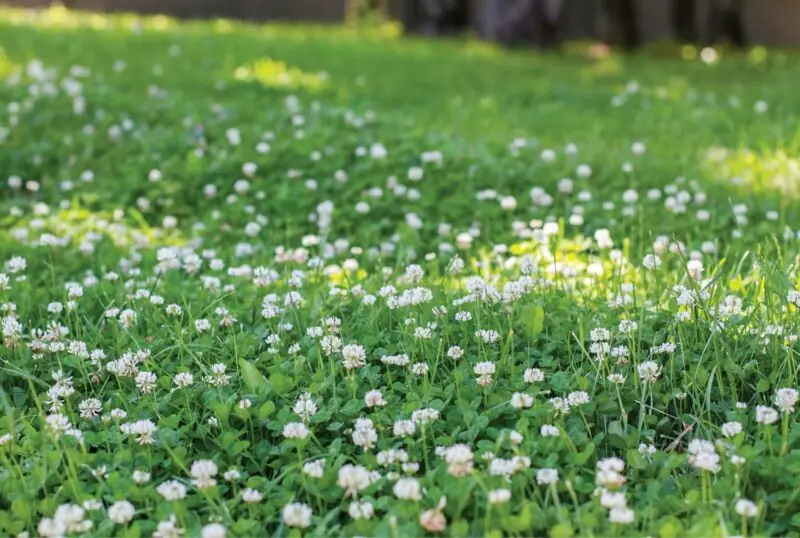
Weeds with white flowers might seem harmless, but they can wreak havoc on your lawn and garden if left unchecked. They are often invasive and can quickly take over an area, choking out other plants that you want to thrive. Proper identification and management of these weeds are crucial for maintaining a healthy outdoor space.
In this article, we’ll discuss some common white flower weeds that may be growing in your yard or garden. We’ll cover their descriptions, habitats, and impacts on the surrounding environment, and offer tips for managing them effectively.
White Clover: The Most Common White Flower Weed
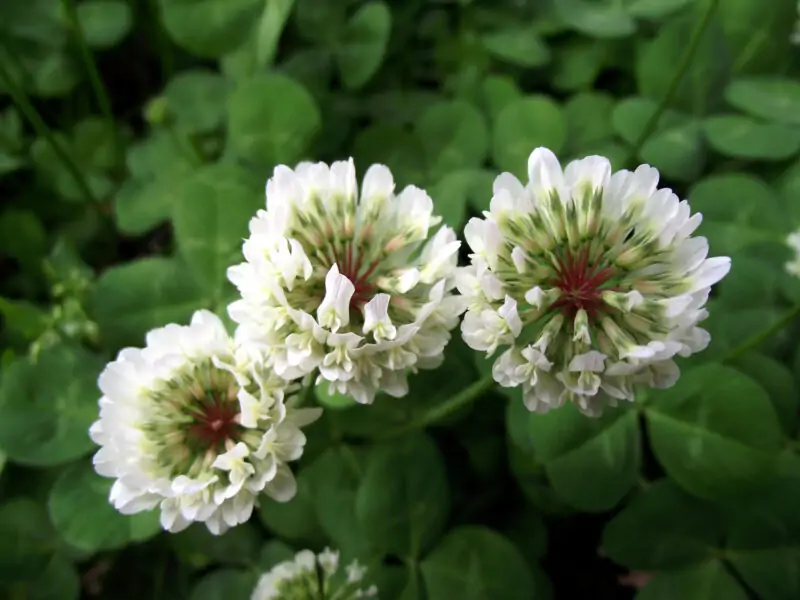
Description and habitat
Scientifically known as Trifolium repens, white clover is a perennial weed commonly found throughout North America in lawns or gardens where grasses grow poorly due to lack of moisture or nutrients. It has three-part leaves, each marked by a pale green chevron shaped like the letter “V”. The plant’s small white flowers bloom from early spring through late fall.
Impact on lawn and garden
While it looks attractive when blooming during its peak season from May to August with tiny delicate blooms resembling balls of cotton wool atop stems about 3-4 inches high, such beauty hides serious problems:
- This weed spreads rapidly using runners called ‘stolons,’ which makes it hard to control.
- Its roots reach up to six feet deep into the soil, making eradication tough because cutting off above-ground foliage does not kill underground growths completely.
- It competes aggressively with other plants, including grass species, resulting in thinning patches, especially under shade trees where sunlight penetration is scarce.
- Can harbor pests that damage other vegetation nearby.
Management methods
- Hand-pulling – For small populations, hand-weeding works well but requires time-intensive efforts as stolon runners make pulling entire rootstock very difficult. Repeat weekly sessions might be necessary until all signs disappear.
- Lawn Care Practices – Proper lawn care practices such as mowing at the correct height, fertilization, and aeration all help prevent white clover infestations from getting worse.
- Chemical control – Herbicides can be effective for larger areas but must be used carefully to avoid harming other plants in the area. It is important to identify which products are most appropriate for your specific needs.
Chickweed: Little White Flowers
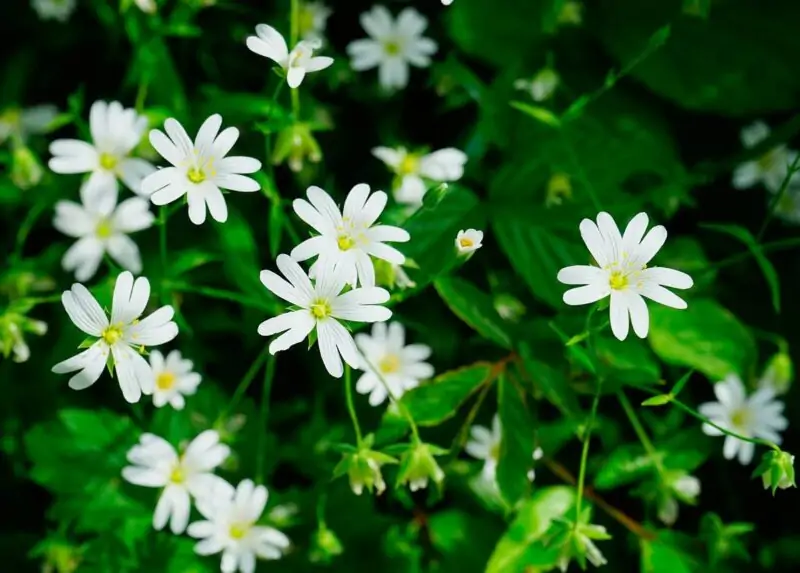
Description and habitat
Also called Stellaria media, this annual weed has small oval leaves that grow opposite each other on thin stems, with tiny white flowers blooming in late winter or early springtime. They provide an excellent source of nectar for pollinators like bees and butterflies. The plant also produces numerous seeds, suitable for both birds’ diets and making it harder against unfavorable conditions.
Impact on lawn and garden
- Competes aggressively against preferred vegetation species by forming dense carpets, creating shaded microenvironments that restrict the growth potential of desired varieties.
- Can harbor pests that create problems elsewhere if left unchecked.
- Can spread rapidly onto neighboring gardens, causing unnecessary pest issues.
Management methods
- Hand-pulling – For smaller populations, hand-weeding may suffice, especially when dealing with young plants that have not yet formed deep roots in the soil. Otherwise, mature specimens need more drastic measures.
- Mechanical Control – When manual removal isn’t enough, use mechanical means: Lawn care companies provide services using machines specifically designed for controlling chickweeds over large areas within short periods, thus reducing further damages caused by spreading throughout the yard or garden space and minimizing future pest issues altogether!
- Chemical Control – Using pre-emergent herbicides prevents germination, whereas post-emergent ones target already growing weeds. Always ensure you follow manufacturer instructions when using chemical agents.
Stinging Nettle: Lawn Weed to Get Rid Of
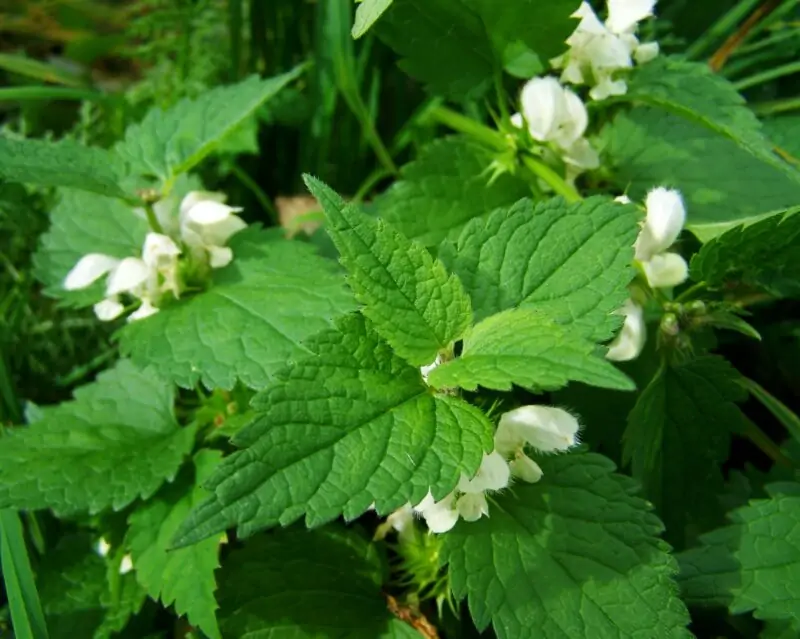
Description & Habitat:
Stinging Nettle (Urtica dioica) is a perennial weed found worldwide, growing in Europe, Asia, North America, and Africa. It can grow up to 7 feet tall and has a stem covered with tiny hairs that contain formic acid, causing skin rash or irritation when touched, hence the name “stinging.” The leaves are dark green in color and have jagged edges.
Impact on Lawn & Garden:
- Stinging nettles are aggressive weeds that compete for nutrients, water, and sunlight with other plants.
- They can quickly spread throughout your lawn or garden through rhizomes, making them difficult to control.
- They can create issues by harboring pests, both beneficial ones such as ladybugs and unwelcome invaders.
Management methods:
- Hand-pulling – For smaller populations, hand-weeding may suffice, especially for young specimens. Wear gloves while doing so!
- Mechanical Control – Using lawn care tools capable of trimming back growth, like weed eaters, will help keep stinging nettles controlled over larger areas within short periods, reducing future pest issues altogether!
- Chemical Control – Use selective herbicides specific only for stinging nettles, preventing damage to preferred vegetation species while eliminating this plant completely. Always ensure you follow manufacturer instructions when using chemical agents.
Yarrow: Perennial Weed with White Flowers
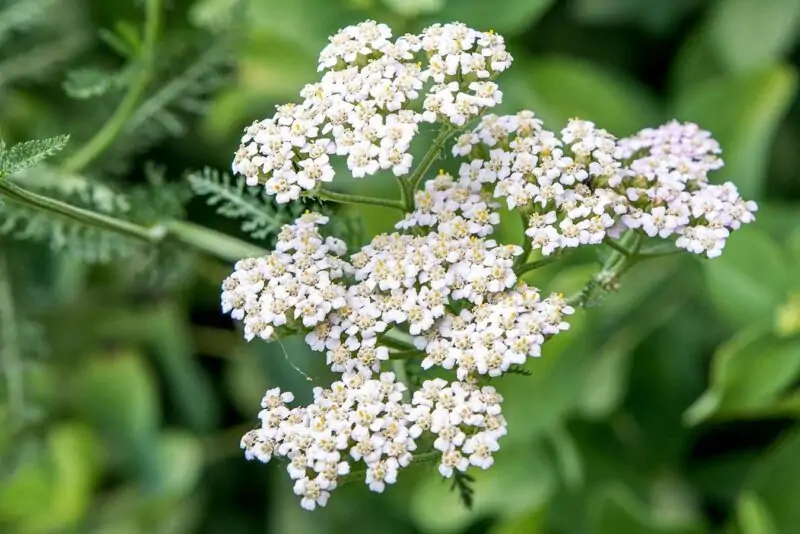
Description & Habitat:
While yarrow (Achillea millefolium) is a weed native to Europe, it has become widely naturalized across North America. It is commonly found growing wild in fields, meadows, ditches, and roadways where soil conditions encourage its proliferation. Yarrow produces small clusters of pale pinkish-white flowers, each measuring about half an inch wide, on stems that rise between one and two feet high. The plant’s delicate appearance complements ferns and other plants with similar foliage.
Impact on Lawn & Garden:
- Yarrow spreads easily via underground runners called ‘rhizomes,’ allowing it to rapidly dominate an area and limit the growth potential of desired plant varieties. This interference with the photosynthesis process can lead to bare patches in areas without adequate sun exposure, such as under trees or in shaded regions, which can be detrimental to maintaining a visually pleasing landscape.
- Yarrow can attract various pests, including unwanted insects and plant diseases, which can negatively impact the health of your garden.
Management Methods:
- Hand-pulling – For smaller populations, hand-weeding may be sufficient, particularly when dealing with young plants. Ensure that you remove the entire root system to help prevent regrowth.
- Mechanical Control – For larger infestations, using manual tools like lawn care implements can be effective. Cut the leaves off at ground level to prevent flowers from setting seed in future seasons, thus minimizing the risk of pest issues.
- Chemical Control – Use selective herbicides that are specific to the yarrow to prevent damage to preferred plant species while eliminating the weed. Always follow the manufacturer’s instructions when using chemical agents to ensure proper and safe application.
Queen Anne’s Lace: Carrot-Looking Flowering Lawn Weed
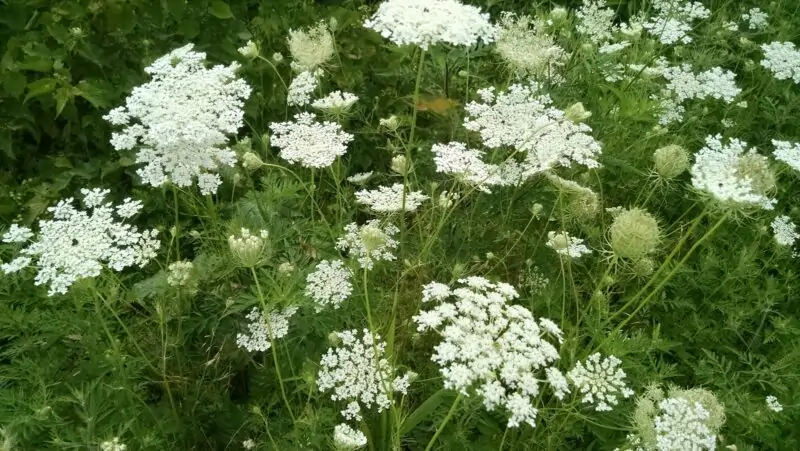
Description and habitat
Queen Anne’s Lace (Daucus carota), also known as wild carrot, resembles the domesticated carrot plant but has smaller roots and leaves than the edible variety. This weed can grow up to two feet tall, with delicate lacy foliage that contrasts with darker green grasses or other plants nearby. Its stems are hairy on top and smooth below, and its flowers have five petals each, which sometimes form an umbrella-like shape at maturity. The blooms consist of small clusters of tiny white florets surrounding one central purple-red blossom. Queen Anne’s Lace typically blooms from May through August, but it can continue until fall in warmer conditions.
This perennial weed prefers disturbed habitats such as roadsides, fields, gardens, meadows, pastures, and abandoned lots. It is mostly found in Eastern North America and is now naturalized in many parts of the world where soil quality allows for comfortable growth.
Impact on lawn and garden
While some people enjoy having Queen Anne’s Lace grow naturally among their ornamental beds, others consider it a pest, as it can readily take over and create dense colonies. This can make it difficult for groundcovers and turf to thrive, and it can potentially harm other plants.
Despite its invasive nature, Queen Anne’s Lace does have some benefits. Its strong taproots help improve soil structure by breaking down compacted earth and improving drainage, as well as bringing nutrients closer to the surface. This can reduce the need for fertilizer use. Bees, butterflies, hummingbirds, and other pollinators are also attracted to these umbels, which serve as a food source during late summer and early fall when few other flowers are in bloom.
Management and eradication methods
To control Queen Anne’s Lace, the best approach is to prevent its spread by removing it before seeds have a chance to be deposited into the soil or dispersed through the wind. Pulling may be effective for small patches, while larger infestations may require the use of herbicides containing glyphosate or triclopyr, which can effectively kill the plant roots. Exercise caution during application to avoid accidentally spraying wanted vegetation or nearby water sources.
Marestail: Ugly and Aggressive
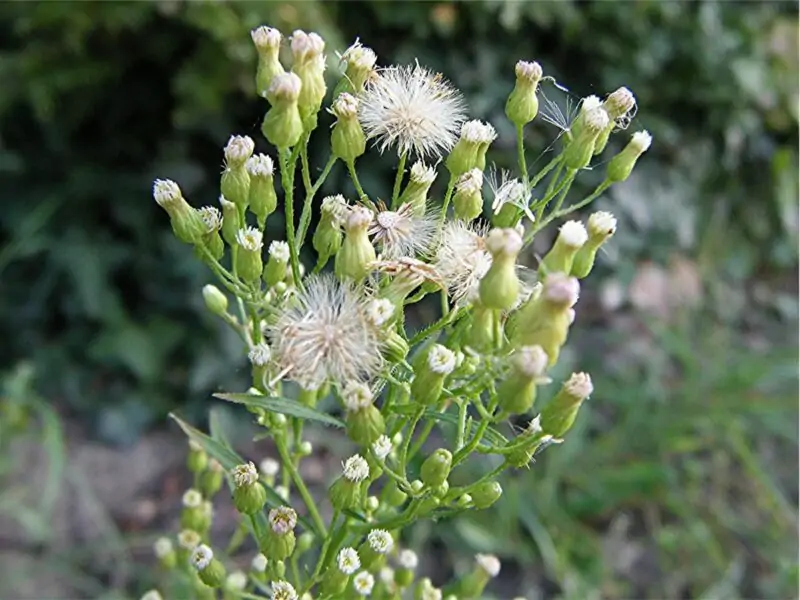
Description and habitat
Marestail (Conyza canadensis), sometimes called horseweed, can grow up to six feet tall at maturity and produce seedheads resembling cotton balls, each containing thousands of individual white fluffy seeds. It blooms from June to October, with its color changing from greenish-gray to brown as it matures. Marestail is an aggressive weed that grows rapidly, choking out weaker lawn grasses and turf beds and potentially creating large monocultures.
Marestail prefers wetland areas but can also grow in dry fields, meadows, pastures, abandoned lots, roadsides, and gardens. It is mostly found throughout Eastern North America and westward until Colorado, and is now naturalized in some parts globally. Its stem contains allelopathic compounds that suppress the germination of surrounding plant species while promoting its own spreading and invasive qualities.
Impact on lawn and garden
Marestail can negatively impact lawns, golf courses, and homeowners alike because once established, mowing or cutting back does not stop it from coming back and trying to take hold again. It is also resistant to most common herbicides, meaning traditional solutions are ineffective, and specialized treatments may be expensive and available only through professionals dealing with unwanted invasions.
However, some studies suggest that adding organic amendments, improving drainage, and planting native and compatible species can help reduce the likelihood of marestail growth over time. Patience and good lawn care practices are essential.
Management and eradication methods
Prevention is always the best way to manage weeds in your yard, including Marestail. Be sure to keep areas surrounding plants clean, cut, and remove dead foliage and debris from garden beds to prevent any chance for the weed to establish itself. For more significant infestations, consider hiring a professional herbicide application tailored specifically to this particular weed species, as traditional herbicides are not effective against Marestail. Removing individual plants can be challenging, as disturbing them can spread seeds through the air, water, and soil, making them even harder to eradicate long-term.
For smaller infestations, you can try the following methods:
- Hand-pulling: Remove young plants by hand, ensuring you remove the entire root system to prevent regrowth. This method is most effective when the soil is moist, making it easier to pull out the roots.
- Mowing: Regular mowing can help prevent Marestail from producing seeds, reducing its ability to spread. However, keep in mind that mowing alone will not eradicate the weed completely.
- Smothering: Cover the infested area with a thick layer of mulch or landscape fabric to block sunlight and smother the plants. This method can be effective in controlling Marestail, but it might take several months or even a full growing season to see results.
- Biological control: Some insects, such as the stem-boring weevil (Rhinocyllus conicus), can help control Marestail by feeding on its stems and foliage. However, this method is not widely used due to concerns about the potential negative impact on non-target plant species.
Remember that controlling Marestail and other invasive weeds requires ongoing monitoring and maintenance. By combining prevention, early detection, and various control methods, you can keep your lawn and garden healthy and weed-free.
Fleabanes: Yellow Flowers with White Petals
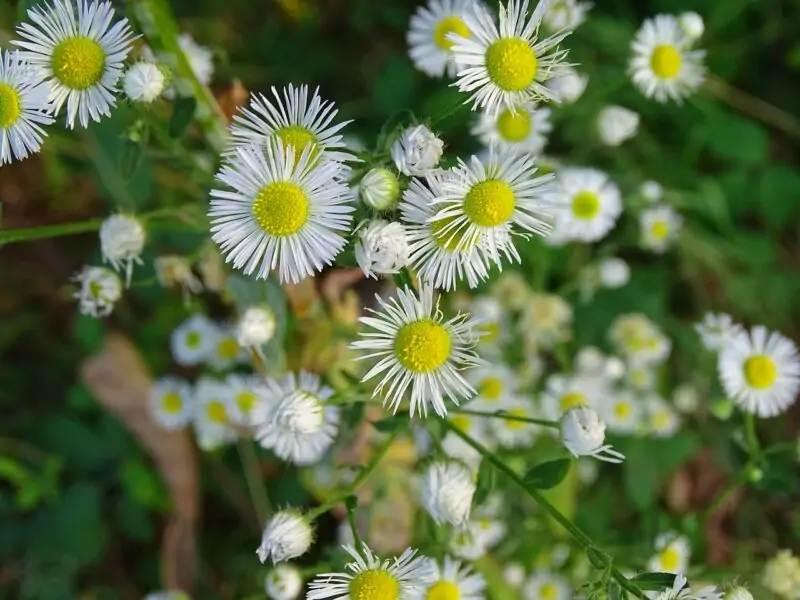
Fleabanes (Erigeron spp.) are tough perennials that grow up to 6 feet tall at maturity, producing masses of small white or pinkish-purple flowers that bloom every summer and fall season.
They prefer open habitats such as fields, meadows, pastures, roadsides, gardens, and lawns but can tolerate other conditions too. They’re found throughout North America and have naturalized in parts of Europe and Asia.
Description and habitat
These plants have hairy stems with leaves ranging from fine thread-like needles to wider broad blades, depending on the species. Though often mistaken for daisies, fleabane usually has a smaller stature and less showy petals than their common kin.
While they don’t cause any harm directly, they can influence fertility and health by encouraging birds and insects to pollinate, complementing ecosystems. Their hardiness and adaptability make them excellent candidates for naturalizing large areas where creating beautiful displays with low maintenance is necessary.
Impact on lawn and garden
Attractive to ferns, butterflies, and moths alike, fleabane is sometimes considered a nuisance because of its tendency to self-seed and spread quickly, out-competing nearby vegetation. It effortlessly takes root in openings along borders, against fences, buildings, hedges, and flowerbeds.
Besides competing for space, nutrients, and sunlight, fleabanes can also host a number of pests and diseases, potentially affecting desirable flora and fauna. As a result, homeowners and landscapers aim to avoid letting them get out of control.
However, some farmers and cultivators appreciate the plant for its ability to attract beneficial insects, helping to balance the ecosystem and reducing the need for synthetic pesticides and herbicides.
Management and eradication methods
To manage fleabanes, it’s best to prevent their spread by removing them before they seed. Hand pulling is effective for small patches; larger ones require the use of herbicides that contain glyphosate or triclopyr, which can kill plant roots effectively, preventing any future growth.
However, since these chemicals can also harm beneficial plants around them, one should exercise extreme caution during application time, making sure not to accidentally spray on wanted vegetation (or nearby water sources).
If Fleabanes are already widespread, consider hiring a professional landscaper trained in removal techniques, including root cutting, mulching, organic composting, soil amendments, drainage improvements, and physical barriers such as fencing. Combine chemical, cultural, and biological options to achieve the desired results while minimizing the impact on the surrounding ecosystem.
Wild Madder: Spreads Quickly
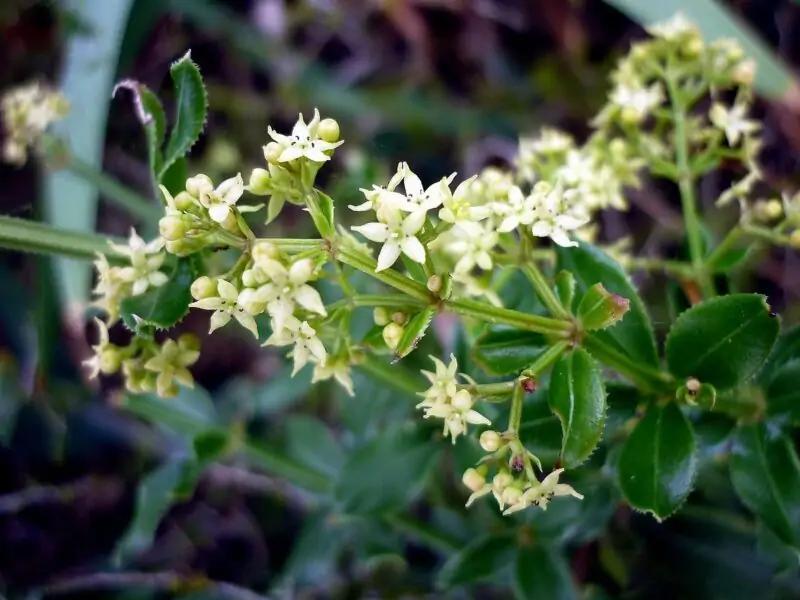
Wild madder (Rubia peregrina), sometimes called creeping Charlie, spreads quickly via its runners, making it a tough weed to control. It prefers wetter soils but will grow anywhere with available moisture. It blooms from May to October, producing small white flowers with yellow centers, though flowerheads tend to merge together into round ball-like clusters, a unique feature in its overall appearance.
Description and habitat
This perennial weed has heart-shaped leaves arranged on opposite sides of the stem, with tiny hairs covering its surface that give it a soft touch when brushed against. In autumn, foliage colors range from greenish bronze to reddish-purple, deepening in the shade as the season winds down.
Although native to Europe and Asia, wild madder has naturalized throughout North America, particularly eastward across the continent, and can be found in many parts globally too!
Wild madder is a useful medicinal plant whose root is used to treat a variety of ailments, ranging from indigestion and liver problems to skin issues, among others. Some gardeners may appreciate its addition to their yard, while others see it as a nuisance, taking over and choking out ornamental beds and grasses alike, competing for resources, and reducing the aesthetic value of the property, forcing unwanted landscaping costs and upkeep expenses.
Impact on lawn and garden
When left unchecked, wild madder competes well with other plants of differing heights and sizes, thereby hindering the establishment and growth of desirable species. Even beneficial insects and pollinators usually skip this particular plant due to its lack of nectar production compared to alternatives.
But as mentioned earlier, wild madder does have some benefits too! Its strong taproots help improve soil structure by breaking down compacted earth, improving drainage, and even bringing nutrients closer to the surface, thereby lessening the need for fertilizer use overall. Furthermore, bees, butterflies, hummingbirds, and other pollinators love these flowers, serving as a food source during late summer and early fall when few other blooms are available.
Management and eradication methods
To control Wild Madder, the best way is to prevent its spread by removing it before seeds or runners have a chance of being deposited into the soil or dispersing through the wind. Pulling may be effective for small patches; larger ones require the use of herbicides containing glyphosate, which can kill plant roots effectively, preventing any future growth.
However, since these chemicals can also harm beneficial plants around them, one should exercise extreme caution during application time, making sure not to accidentally spray on wanted vegetation (or nearby water sources).
If Wild Madder has already become widespread, consider hiring a professional landscaper trained in removal techniques, including root cutting, mulching, organic composting, soil amendments, drainage improvements, and physical barriers such as fencing. Combine cultural and biological options to achieve desired results while minimizing the impact on the surrounding ecosystem.
Mayweed: Not to Be Confused with Daisy Weed
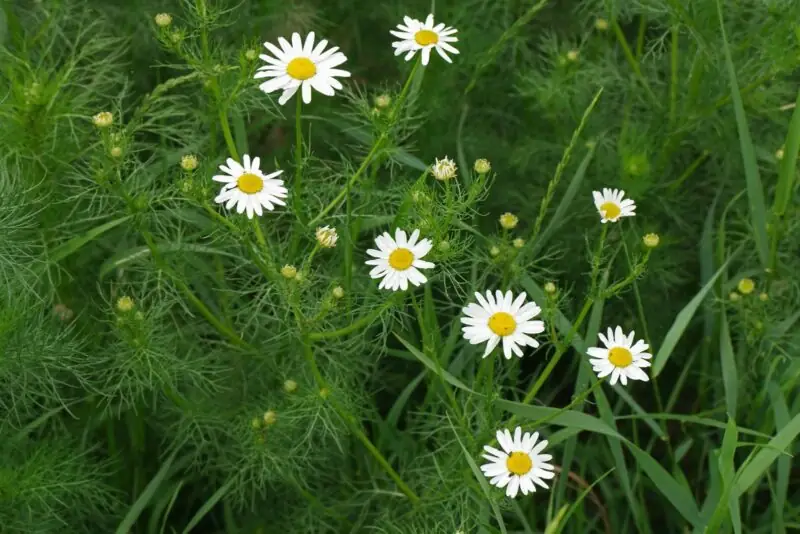
Mayweed (Matricaria discoidea), also known as pineapple weed or wild chamomile, is a common weed with white flowers that can be found in lawns and gardens across North America. This annual plant grows up to 12 inches tall and has small yellowish-white flowers that resemble miniature daisies.
People who are not familiar with mayweeds often confuse them with daisies, which are also one of the best-known lawn weeds.
Description and habitat
Mayweed prefers disturbed areas such as garden beds, footpaths, driveways, roadsides, and other types of waste ground. It thrives in full sun but can tolerate light shade.
The leaves are finely divided into thread-like segments which give the plant an airy appearance. The stems are hairless and slightly swollen where they join the stem nodes, giving them a knobby look.
Impact on lawn and garden
Although mayweeds do not pose any significant threat to your lawn or garden’s health when it comes to competition for nutrients or water due to their shallow root system, they still have some negative impacts on humans’ well-being:
- Its leaves emit a strong odor resembling pineapples when crushed
- It has been used historically by Native Americans for medicinal purposes
- However, some people might suffer from skin irritations if exposed to too much
If left unmanaged, this invasive species will spread quickly throughout lawns, creating unsightly patches where grass once grew.
Management and Eradication Methods
- Hand pulling: If you have only one or two plants, then hand-pulling could work well as long as you get all roots out.
- Herbicides: Use a glyphosate-based herbicide if there’s a severe infestation. Reseed after applying chemical control products.
- Cultural practices like regular mowing at the correct height, and watering correctly, thereby make the environment hostile for its growth.
Pearlwort: Tiny White Flowers
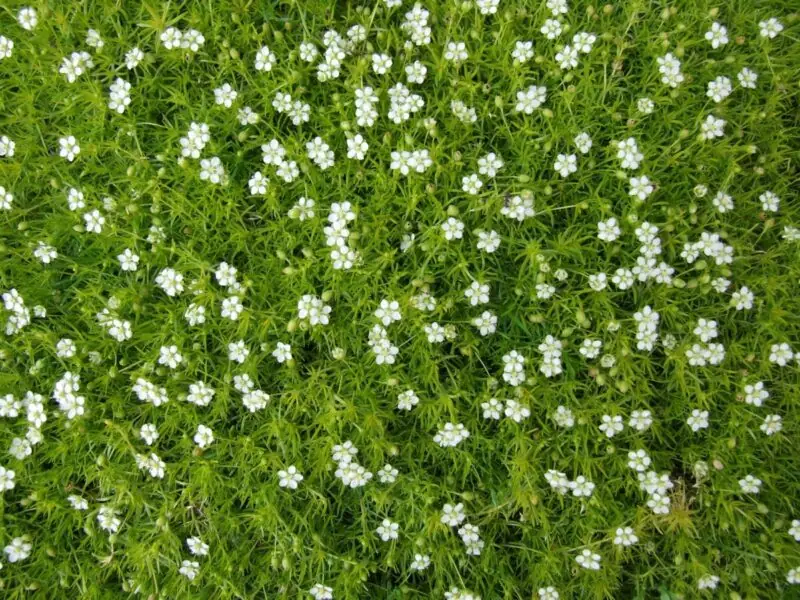
Pearlwort (Sagina spp.) is another type of common perennial weed with white flowers often found in damp soil, rock gardens, and lawns. It is a low-growing plant with dense tufts of small leaves and white flowers that appear in late spring to early summer.
Description and habitat
Pearlwort has hairy stems which are thin and wiry. Its leaves grow close together, forming mats or cushions on the ground around 1-3 cm high, from where its tiny white flowers bloom.
They prefer compacted soil conditions, hence commonly found growing in walkways, driveways, cracks between concrete slabs, etc.
Impact on lawn and garden
Although pearlwort doesn’t pose any significant damage to your lawn if controlled properly, it can become unsightly when allowed unchecked infestation due to its spreading rhizomes.
When they spread too much, they usually compete with grasses, thereby leaving brown patches all over your garden.
Management and Eradication Methods
• Hand-pulling: If you have only one or two plants, then hand-pulling could work well as long as you get all roots out.
• Mowing regularly at the correct height
• Applying herbicides like non-selective glyphosate-based products.
Common Boneset: Tall and Smelly
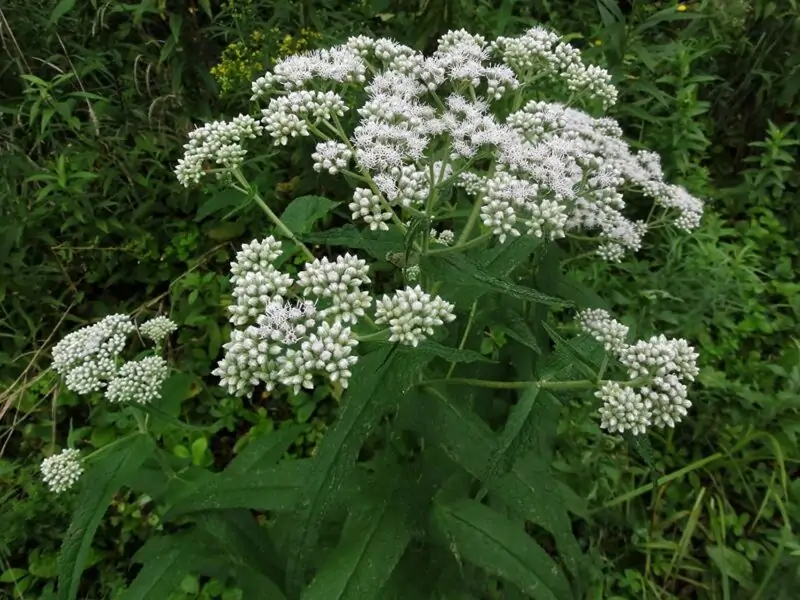
Common boneset (Eupatorium perfoliatum) is yet another type of weed that produces white florets that grow in clusters. It belongs to the Asteraceae family. This perennial weed grows up tall, sometimes reaching up to 5 feet.
Description and Habitat
Bonesets have square stems covered in fine hairs which support opposite pairs of large, serrated-edged leaves. Their stem extends down through each leaf, creating an interesting effect known as “perforation.” The flowerheads consist entirely of many small petalless disc flowers arranged closely packed together into flat-topped clusters.
These weeds prefer damp areas such as marshlands, banks beside rivers, and creeks. They thrive best under full sun but can tolerate some shade as well.
Impact on Lawn and Garden
Though common boneset is not harmful to your garden, it can be a nuisance and take over in wet areas. Its leaves also produce an unpleasant odor when crushed. The presence of boneset can be unwanted in lawns and garden beds where it competes with desired plants for space and nutrients.
Management and Eradication Methods
• Hand-pulling: Remove the weed along with the roots. This method is most effective when the soil is moist, making it easier to pull out the entire root system.
• Mowing: Regular mowing can help reduce seed production and control the spread of common bonesets in lawns. However, this method may not be as effective in garden beds or areas with taller plants.
• Herbicides: Use glyphosate or dicamba-based selective herbicide for efficient control. Apply herbicides according to the label instructions, and be cautious not to harm nearby desirable plants.
FAQs
There are several ways you can eradicate white flowering weeds from your lawn or garden:
Physical removal – this involves pulling out the entire plant by hand.
Chemical control – use of herbicides like glyphosate applied directly onto weed’s foliage to kill them off.
Pre-emergent herbicides prevent germination before they sprout.
It’s important to remember that some methods could damage desirable plants if used carelessly.
To prevent the spread of common white flowers weeds, there are various things you could do such as:
Maintaining good yard hygiene (regular mowing, watering at correct intervals)
Plant cover crops during fallow periods which compete well against these invasive species.
Including a mulch layer around beds to prevent their seeds from reaching the soil, thereby restricting their growth.
Remember, prevention is always better than cure.
Absolutely! Some types of weeds have edible and medicinal uses. They add diversity to the ecosystem, providing food sources for insects, humans, etc. For instance, stinging nettle has been used historically as medicine, while daisy-like chamomile flowers make great soothing teas.
We just need to recognize each one’s strengths & weaknesses.
Some of the most common mistakes people make when attempting to manage weeds with white flowers include:
Waiting too long before tackling them.
Not identifying each weed correctly, thereby leading to improper control methods being employed.
Using non-selective herbicides that also kill off beneficial plants alongside these weeds.
Hence, it’s important to not only identify each type of weed but also to know the correct control techniques.
Conclusion
In conclusion, managing and eradicating weeds with white flowers is an essential aspect of maintaining a healthy lawn or garden. Understanding what types are growing in your yard and how best to deal with them will only benefit you in the long run. Maintaining cultural practices along with the use of selective herbicides can help prevent their growth from taking over areas where grass once grew well, thereby making the landscape more attractive & healthier for all members living there.